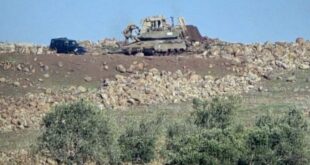Israel’s air strike on Monday in Damascus, which killed five Iranian commanders including two generals and the head of Iran’s operations in Syria and Lebanon, struck at the heart of Tehran’s foreign operations.
Hitting the Iranian consulate was also unprecedented, breaching the Vienna Convention, designed to protect diplomats and their facilities. Iran and Israel are both signatories, but Israel has not ratified the convention.
Brig Gen Mohammad Reza Zahedi, the most senior victim of the strike, is described by Iranian media as “the defender of the holy shrine” – a likely reference to the Shiite religious site the Sayyidah Zaynab Shrine in Damascus.
In that country’s civil war, in which the role of the Islamic Revolutionary Guard Corps was pivotal, Shiite recruits were given encouragement that their involvement in the Syrian civil war was, in part, defending holy sites.
In Lebanon, he worked alongside Hezbollah commander Imad Mugniyeh, who was assassinated by Israel in Syria in 2008, advising and assisting the Iran-backed Hezbollah militia in some of their most dangerous operations, including a jailbreak and cross-border raids.
But he was most vital for Iranian operations in Syria. He took command of IRGC operations in 2008 and helped co-ordinate relations between Damascus and Tehran at a time when Syria explored improved ties with the US.
When Washington-Damascus talks collapsed during the uprising against Bashar Al Assad in 2011, Brig Gen Zahedi helped build networks of Iran-backed paramilitary groups, known for brutality against civilians, helping suppress the rebellion in a decade of bloodshed.
That intervention, alongside the work of the late head of the IRGC’s Quds Force Qassem Suleimani – a man considered a legend by his supporters – is credited with saving the Assad regime. The Quds Force is an expeditionary unit tasked with training allied militias such as Lebanon’s Hezbollah.
Domestically, he was a key regime enforcer, heading the Thar Allah security force in Tehran between 2005 and 2008, a force tasked with cracking down on dissent.
Born in 1960, he joined the new Islamic Revolutionary Guards Corps in 1980, one year after the ascendance of a Shiite theocracy in Tehran, which ousted the pro-West Shah.
His rise through the ranks was rapid. At just 20, he was leading a battalion of soldiers in the eight-year-long Iran-Iraq war which claimed about one million lives. In Syria, he helped establish a number of local armed groups, as well as co-ordinated Iraqi, Afghan and Lebanese Shiite recruits and units.
One unit his force founded, the Qamr Bani Hashim Division – named in reference to Shiite theology – shares its name with his unit during the Iran-Iraq war.
His experience as a young commander fighting Iraq would prove key to rising through the IRGC. Maj Gen Suleimani said the conflict was his most formative experience.
“The youths who were more deeply involved in the war have in today’s society become the more successful administrators – because they administered [affairs] during the most difficult of times,” Maj Gen Suleimani said, describing the conflict as a pilgrimage on which soldiers “sacrificed their lives with absolute loyalty” to make Iran’s Supreme Leader, Ayatollah Khomeini “smile”.
Al Mayadeen, a pro-Hezbollah news outlet in Lebanon, described him as “one of the most prominent leaders of the Quds Force … Martyr Zahedi was the deputy chief of IRGC operations. He also took positions as the leader of both the IRGC’s Air Force from 2005 to 2006 and the Ground Force from 2006 to 2008”, saying he also had a role to “deliver weapons to Gaza”.
That role may date back as far as the late 1990s and early 2000s, when Hezbollah and Iran co-ordinated supplies to Palestinian Islamic Jihad, according to an analysis by Matthew Levitt, an analyst focused on Iranian militancy.
During his command in Lebanon in 2000, Hezbollah launched a spring offensive against occupying Israeli forces, defeating the group’s proxy ally, the Christian-dominated South Lebanese Army at the battle of Khiam, an operation to free prisoners in a prison complex in a town of the same name, which contributed to the rout of the SLA and Israel’s eventual withdrawal from southern Lebanon, which it had occupied since its invasion in the early 1980s.
It is this co-ordination of different groups that has become more critical for Iran over the years, and something Brig Gen Zahedi was obviously adept at, as Tehran’s allies have grown in reach from groups opposing the US occupation in Iraq to the Houthis in Yemen, who have closed down a key international waterway in the Red Sea.
 Eurasia Press & News
Eurasia Press & News



